If you are a bug magnet like I am, you are going to appreciate this (dare I say) life-changing project! Make these DIY citronella candles and experience for yourself how well an effective mosquito repellent candle can work! I especially appreciate that these candles are made with all-natural materials, with no toxic harmful ingredients included.
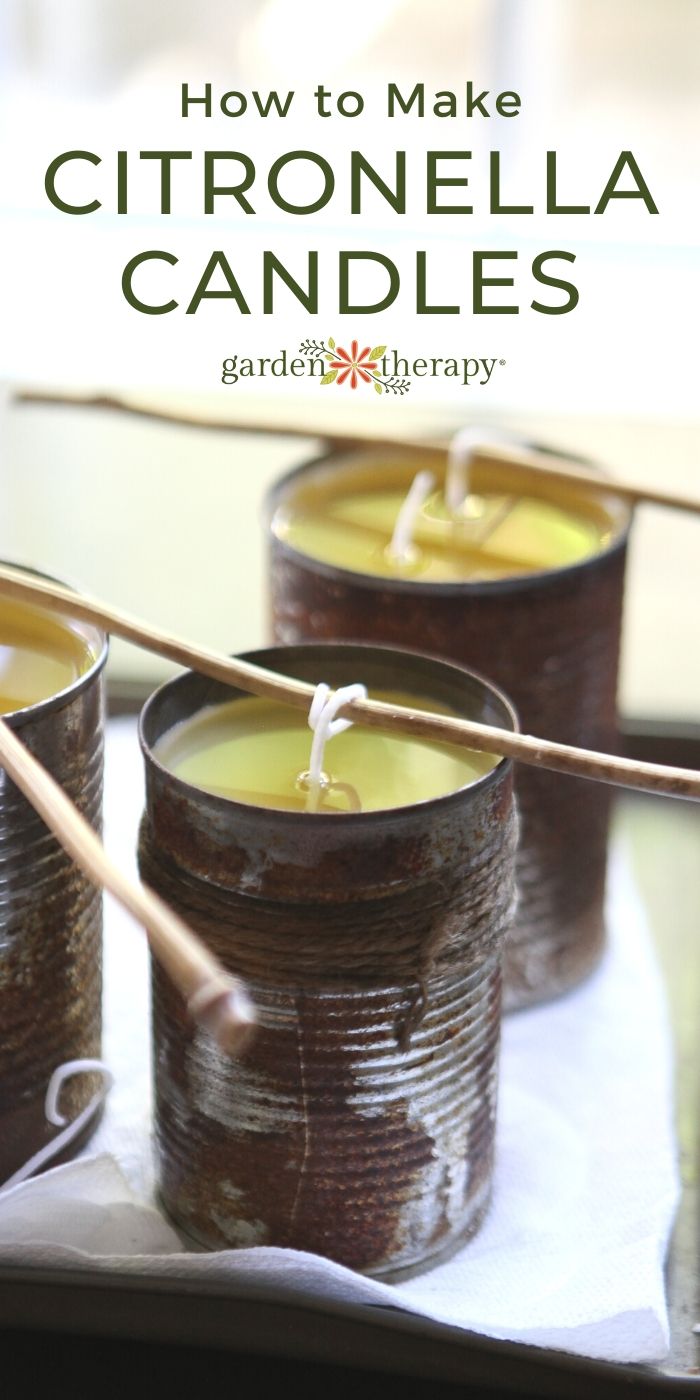
If you are anything like me, the summer months are the perfect season to spend time outside. In typically cooler climates like where I live, the long, warm summer days are perfect for gardening and soaking up the sun outside. There’s just one tiny problem: mosquitoes.
I don’t know what it is, but mosquitoes seem to absolutely love me (that love is not returned!). Mosquitoes leave me with large, itchy welts as they feast in morning and evening hours. Ugh!
Thankfully, after years of experimenting and lots of trial and error, I have developed a few methods for keeping these pests at bay naturally. One of my favorite methods is these DIY citronella candles.
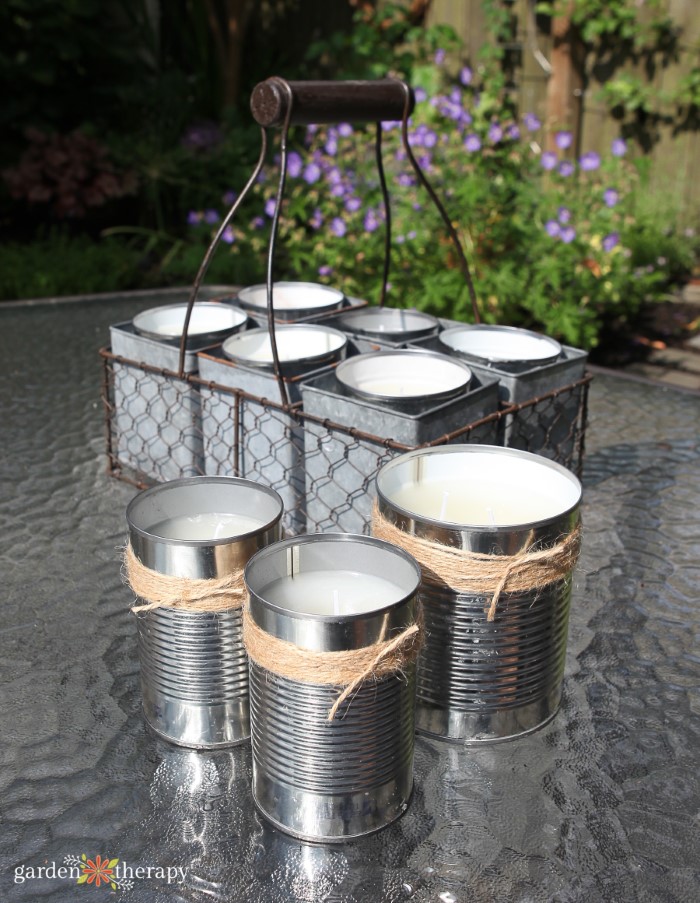
Do citronella candles really work?
I originally published this post in 2016, and since then, there’s been a lot of discussion surrounding the topic of citronella candles and their effectiveness for repelling mosquitoes.
Lately, there’s been several articles published citing a study claiming citronella candles don’t work. However, that’s not what the study actually shows. The studies say if you are trying to protect yourself from Zika, Malaria, or other mosquito-borne illnesses, you should not rely upon a citronella candle. I completely agree with this! If you are going somewhere where those diseases are heavily present, or if you are higher-risk, I would not rely on citronella to keep you safe.
That being said, if you are out in your garden, or on your patio having a glass of wine, and you put a few of these candles around to protect your space, they can be effective. Not because mosquitoes are disgusted by the smell, but rather because it can help mask your scent. As you burn the candles, it consistently releases the oil into the air, which keeps your scent hidden.
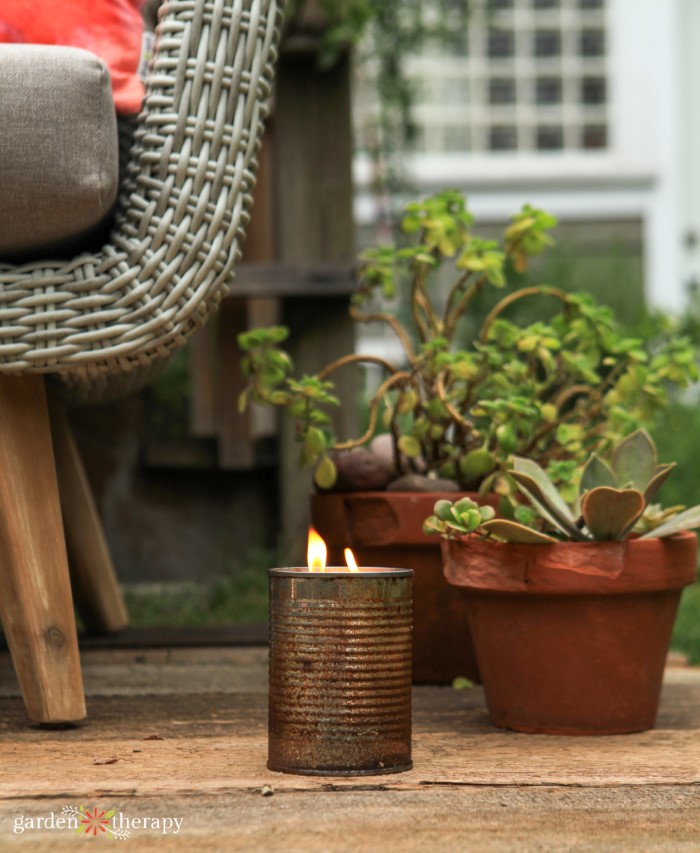
The studies have shown that citronella candles work about 40% of the time. This means that 60% of the time, you may end up with bites. I’d still much rather use an all-natural bug spray in combination with citronella candles to reduce the chances of me getting bitten than dose myself in DEET and chemicals daily just to prevent bites. Is it 100% effective? No. But, when used in combination, I think it can be an effective ally in the fight against mosquitoes.
That’s why I arm myself with a combination of citronella candles, my mosquito-repelling container garden, and my DIY bug spray that uses natural essential oils. This combination is an effective one-two punch that keeps those pesky mosquitoes far, far away without exposing myself (and my garden!) to any harmful chemicals.
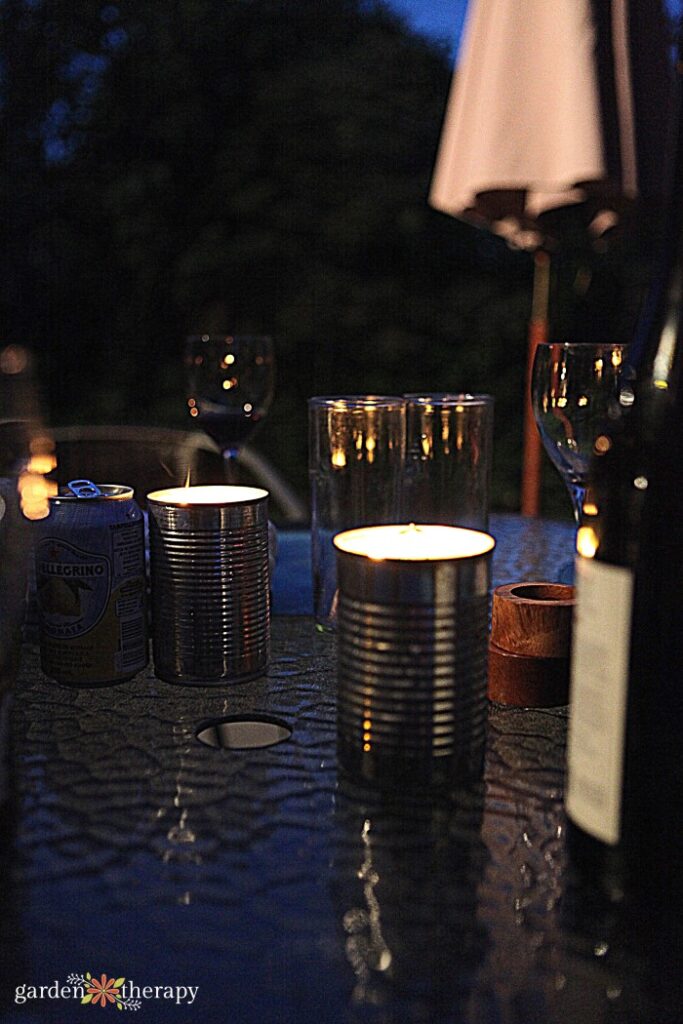
Other Scents to Use in Citronella Candles
Truth be told, I’m personally not overly crazy about the smell of citronella, but I’ll happily deal with it to avoid performing a constant ridiculous-looking dance of smacking myself to kill the flying pests.
While the most effective candles will still be primarily citronella, feel free to add a few other fragrances. To make the candles smell better to me (but still effective), I have played with adding a couple of additional scents to my latest batch of citronella candles such as:
You may have to experiment a bit and see which combination you like best, but that’s part of the fun of making DIY candles.
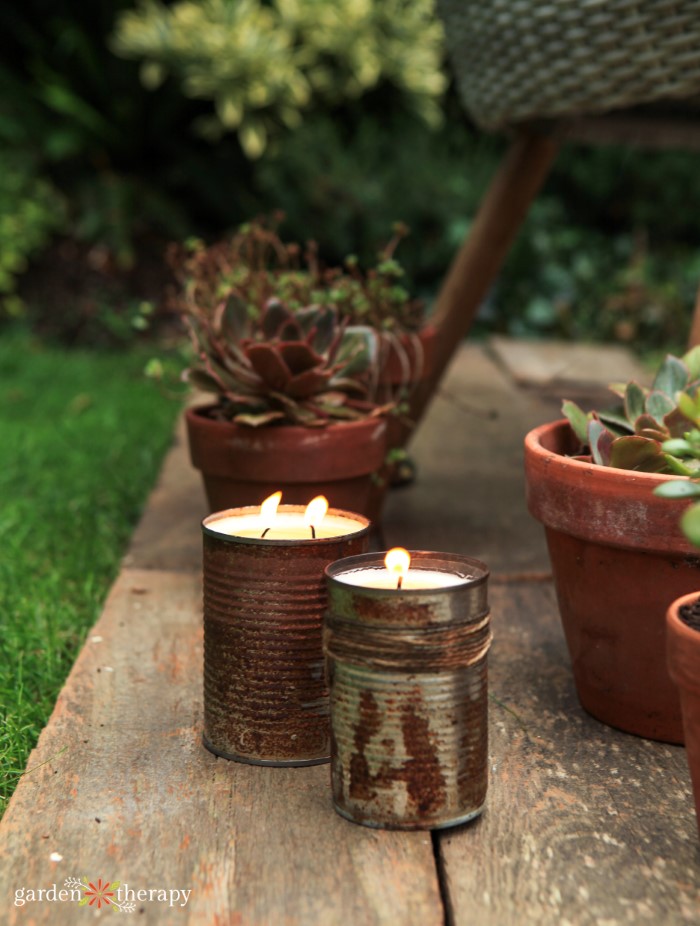
How to Make Citronella Candles
With a few simple, natural ingredients and just a little bit of time, you will have your own mosquito repellent candles to use all around your yard!
Materials Needed for DIY Citronella Candles
- Container – I used cans but you can also use glass jars (see more info below)
- A double boiler (or here is a handy candle making kit)
- Wax (soy wax, paraffin wax, old candles)
- Pre-waxed wicks with tabs (150mm / 6”)
- Citronella oil for candle making (use 1 oz per lb of wax)
- Optional – other scents to add in with the citronella
- Hot glue gun
Step by Step Directions for Making Citronella Candles at Home
1. Add the wicks to the center of your can or container. The best way I have found to use this is with a hot glue gun. Make sure to press the wick down firmly (and carefully as the hot glue can burn).
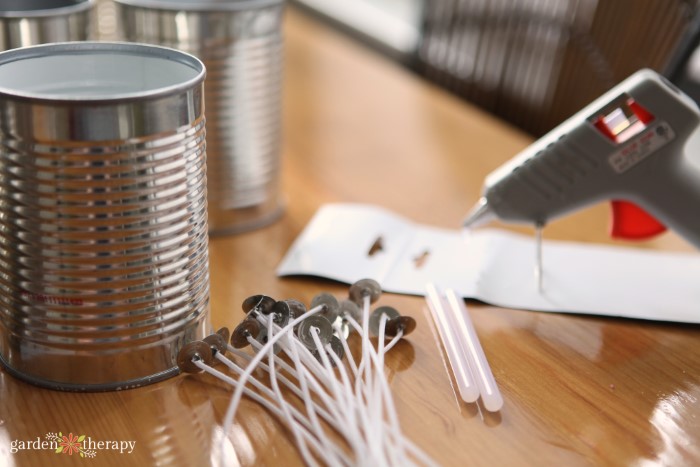
If you are using a larger container, you can add two or three wicks spaced apart around the center.

2. Assemble your double boiler and add wax or old candles in small pieces. Don’t worry so much about bits of wick or other specks in the wax as you won’t see them in the candles when they are done.
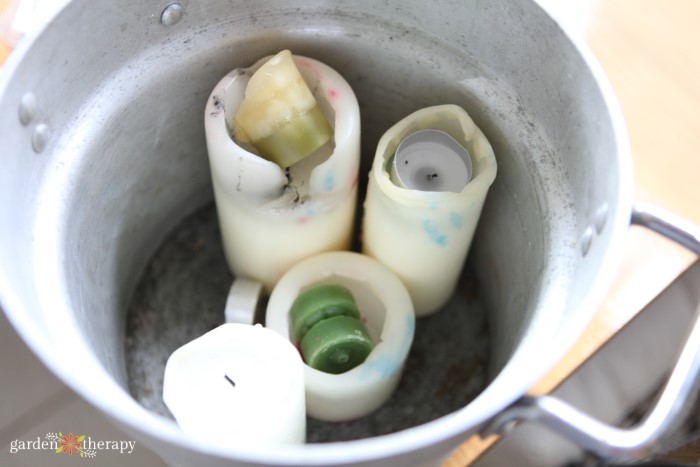
3. Heat the wax over medium heat until it is completely melted. This won’t take too long. Stir every once in a while to help it melt evenly.
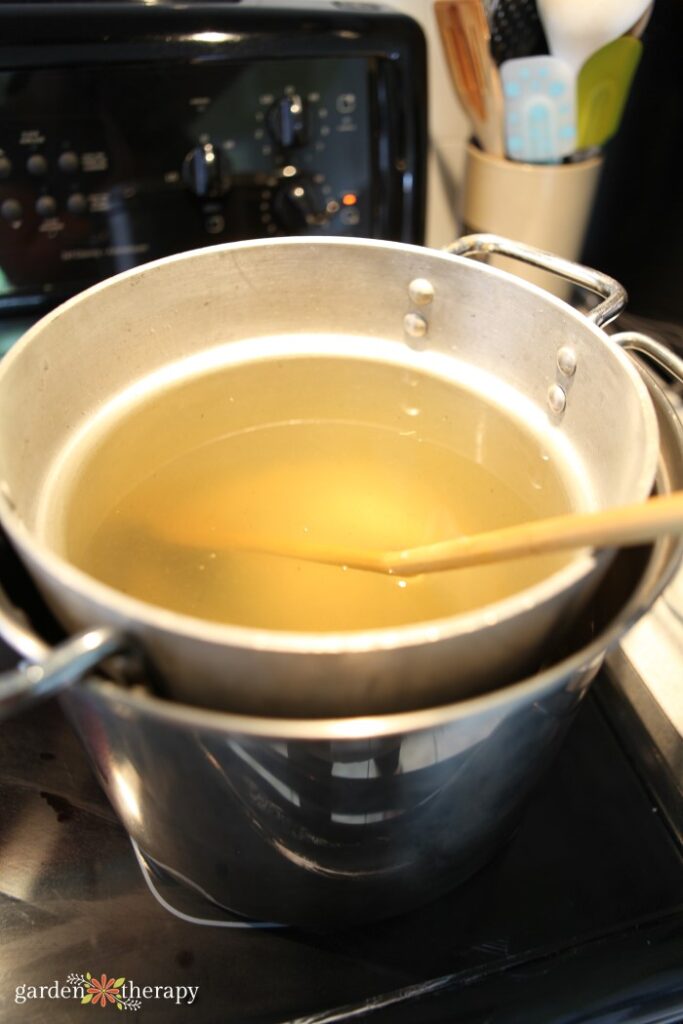
4. When the wax is melted, it’s time to add the fragrance. Add 1 oz of citronella oil per pound of wax and augment the scent with 0.5 oz of other scents per pound. If you prefer just citronella, you can use 1.5 oz per pound.
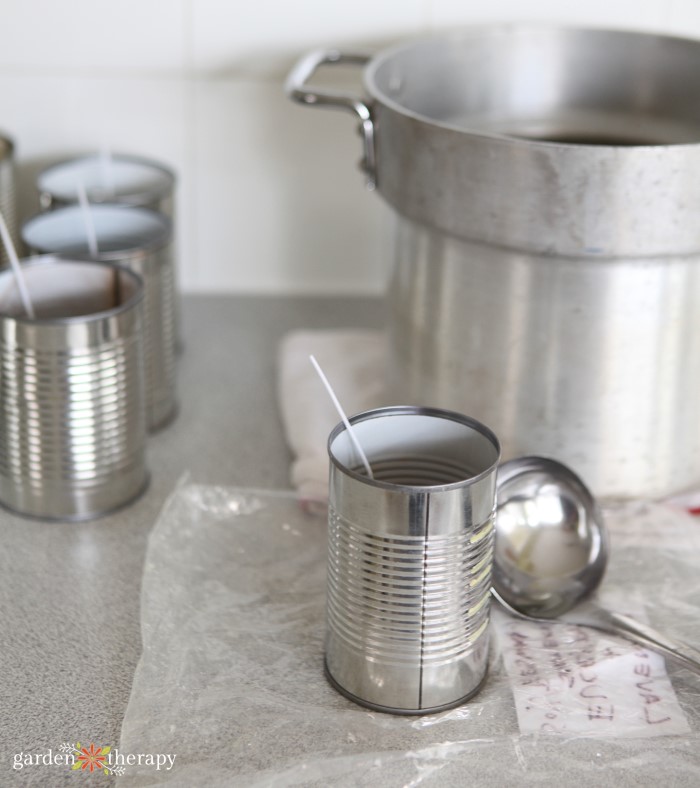
5. Let the wax cool slightly and carefully pour into containers. I can usually gently maneuver my wicks to stay in the center as the wax cools, but if you are having trouble, secure the wicks with a chopstick or clothespin to keep them in line.
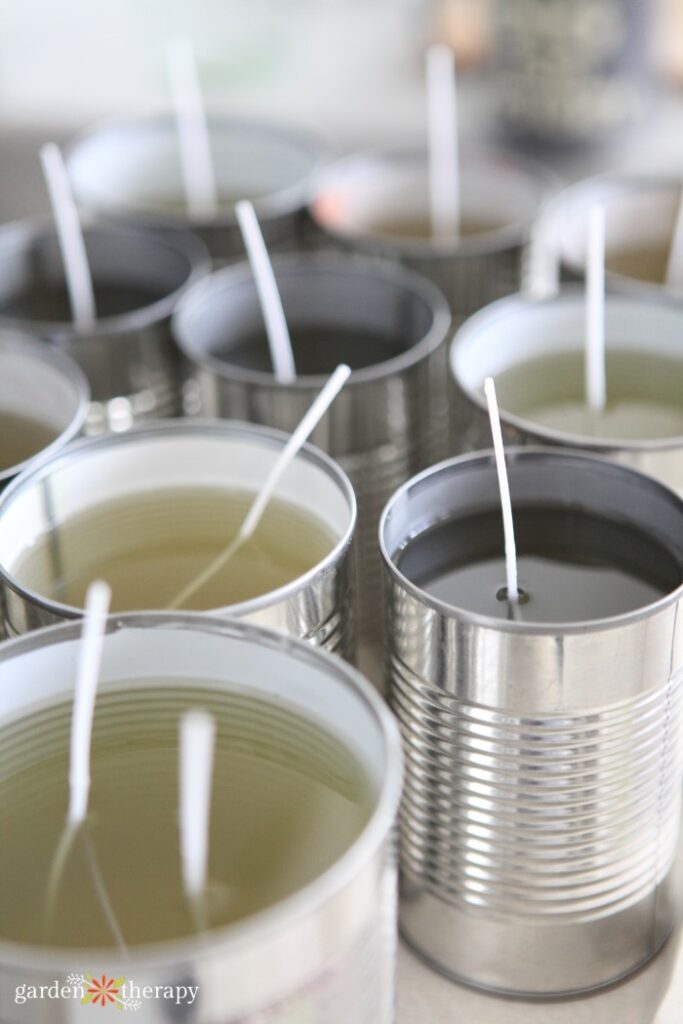
6. Allow your candle to cure for 48 hours undisturbed before burning. Trim the wick to about 1/4 inch before you light it. Then, once it’s lit, let the candle burn so that there is a full, wide pool of wax before you blow it out. This is how you get an even burn for the life of the candle.
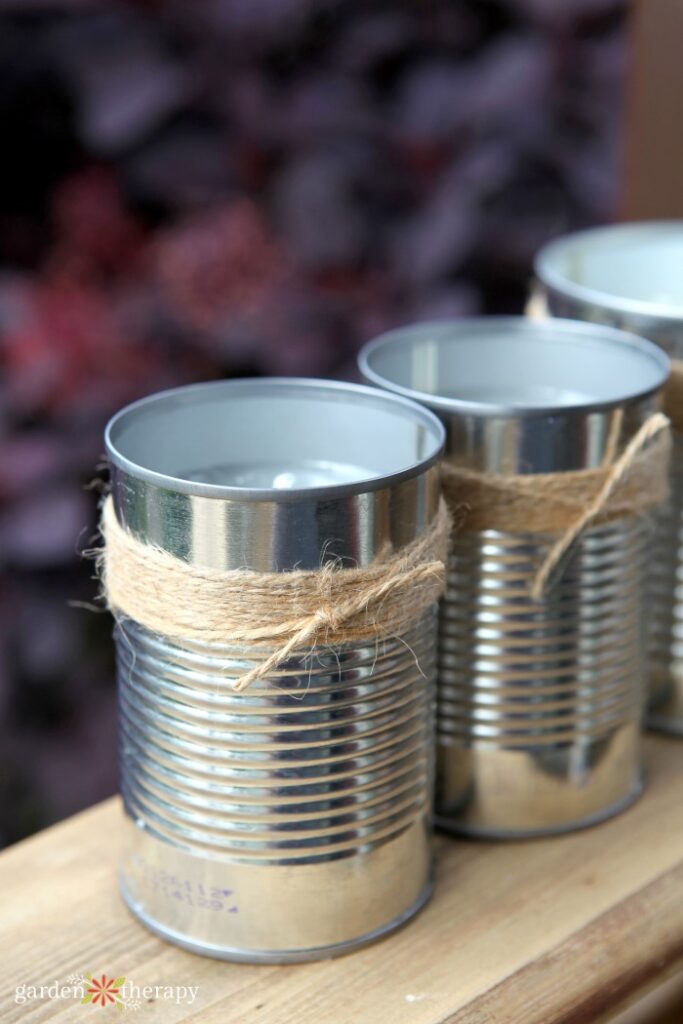
Citronella Candle-Making: Helpful Tips
If you are new to making candles (or making citronella candles), take a quick look at these helpful tips to ensure success with your efforts!
- Be careful not to disturb them too much and set them in a warm place to cool. Cooling slowly and completely will create the best looking candles.
- If you get a depressed area around the wick when cooled, warm up some more wax and pour it into the void.
- Decorate your citronella candles by wrapping them in burlap, twine, and/or yarn.
- Store them near the garden, deck, or patio so you can quickly light up when the pests start buzzing around.
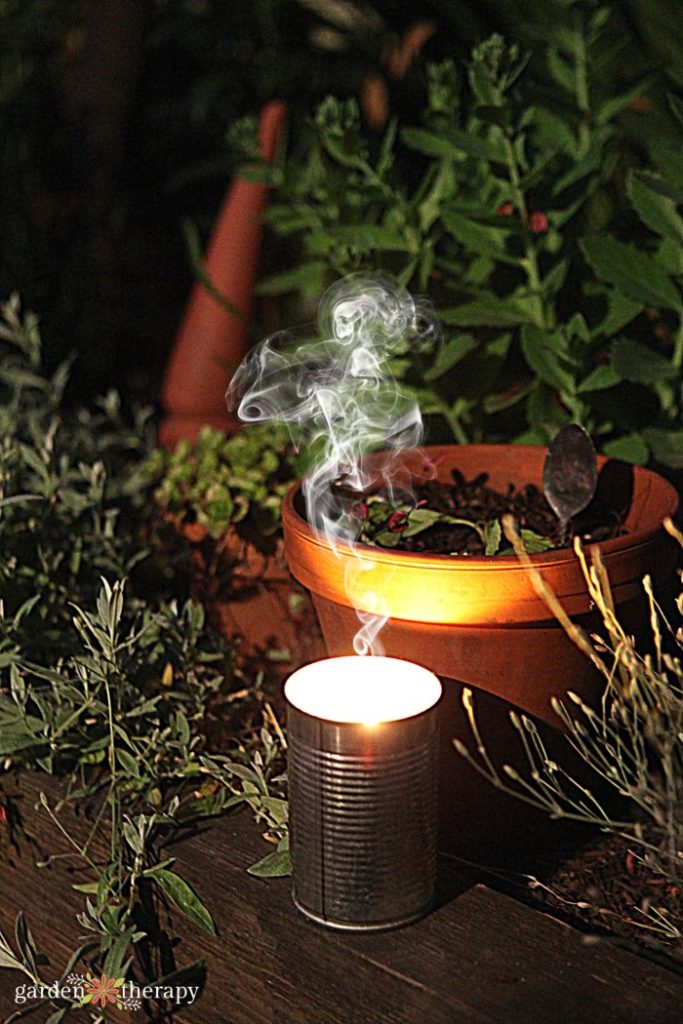
Re-Use Old Supplies to Save Money
Even though this project is fairly inexpensive, there are costs involved – and ways to save a little bit of money. Here are some helpful tips to help you save a little when making your citronella candles.
Reuse Containers
You may notice from the pictures that these mosquito repellent candles are in cans. I love this project because making citronella candles in cans is not only a great, natural way to keep mosquitoes at bay, but it’s also a great recycling project that reuses your cans. Plus, it’s a simple and inexpensive project, much like the Soy Beeswax Jar Candles I made not too long ago.
I love using old metal cans for this project. They don’t even have to be shiny. Rusty ones look amazing! However, if you don’t have any cans, you can also use glass jars.
My only caution for you when using glass is to not use very large glass jars. I recommend keeping them to pint-size or smaller so that the glass doesn’t break when the hot wax heats up the jar.
Don’t have any cans available? Try making your citronella candles in terracotta pots this summer.
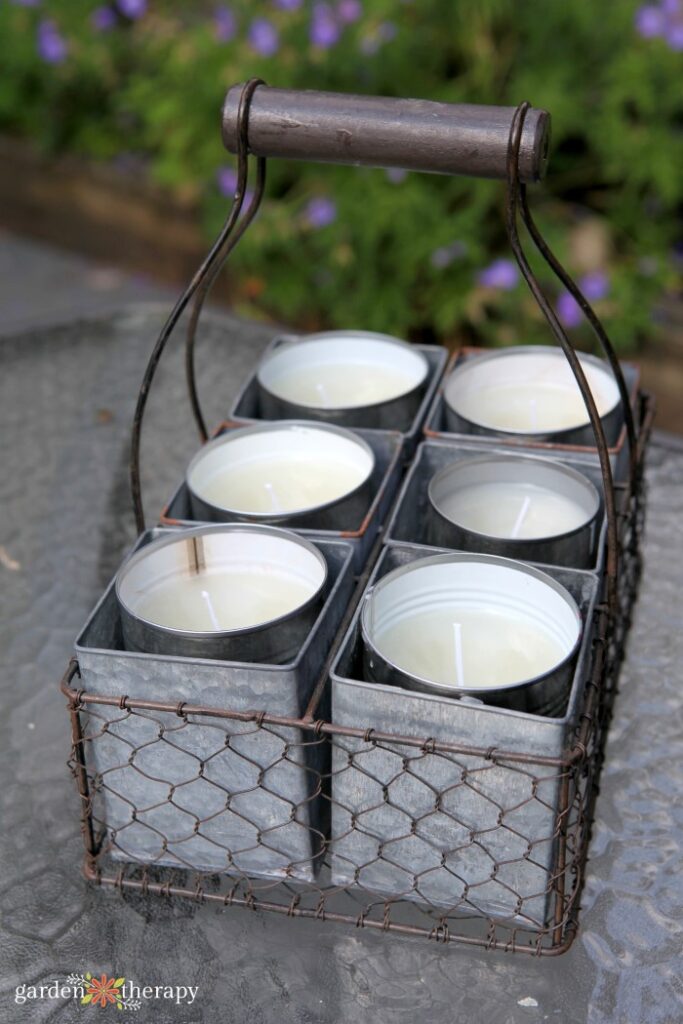
Reuse Old Wax
The cost of wax is the most costly part of this project. If you want to cut down costs, scrape old wax out of previously used containers and melt it back down for your new candles.
Tip: If you want to try this, freeze your containers with old wax overnight, then the next morning, take a butter knife and carefully peel the wax away from the edges of the container. You’ll likely have chunks coming out at a time!
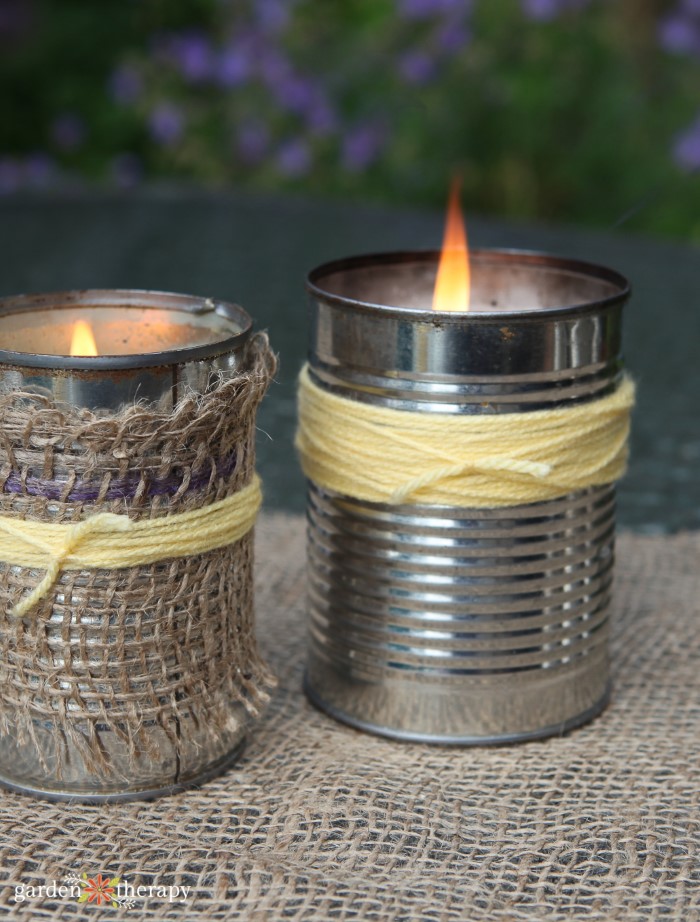
I hope that this guide helps you to make your own citronella candles easily!
More Candle-Making Posts To Read:
- Frozen Garden Candles Blend Fire And Ice
- Easy Ideas For Making Homemade Candles As Gifts
- Rosemary Pressed Herb Candles
DIY Citronella Candles
Equipment
- 1 Hot glue gun
Supplies
- 2 Cans
- 1 lb Wax (soy wax, paraffin wax, old candles)
- 2 Pre-waxed wicks with tabs (150mm / 6”)
- 1 oz Citronella oil for candle making (use 1 oz per lb of wax)
- Other scents for candle making like pine, mandarin orange, eucalyptus, peppermint
Instructions
- 1. Using the hot glue gun, affix the wicks to the bottom of the cans and press it firmly into the center.If you are using a larger can, add two or three wicks spaced apart around the center.
- 2. Assemble your double boiler and add wax or old candles in small pieces. Don’t worry so much about bits of wick or other specks in the wax as you won’t see them in the candles when they are done.
- 3. Heat over medium heat until the wax is completely melted.
- 4. When the wax is melted, it’s time to add the fragrance. Add 1 oz of citronella oil per pound of wax and augment the scent with 0.5 oz of other scents per pound.
- 5. Let the wax cool slightly and carefully pour into containers. I can usually gently maneuver my wicks to stay in the center as the wax cools, but if you are having trouble, secure the wicks with a chopstick or clothespin to keep them in line.
- 6. Allow your candle to cure for 48 hours undisturbed before burning. Then, when you fire it up, let the candle burn so that there is a full, wide pool of wax before you blow it out. It is said that candles have a memory, so it’s best to let the first burn set the tone for all the rest.

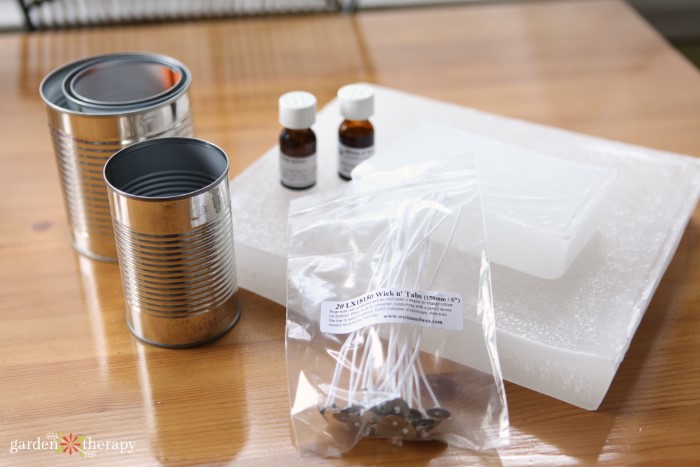

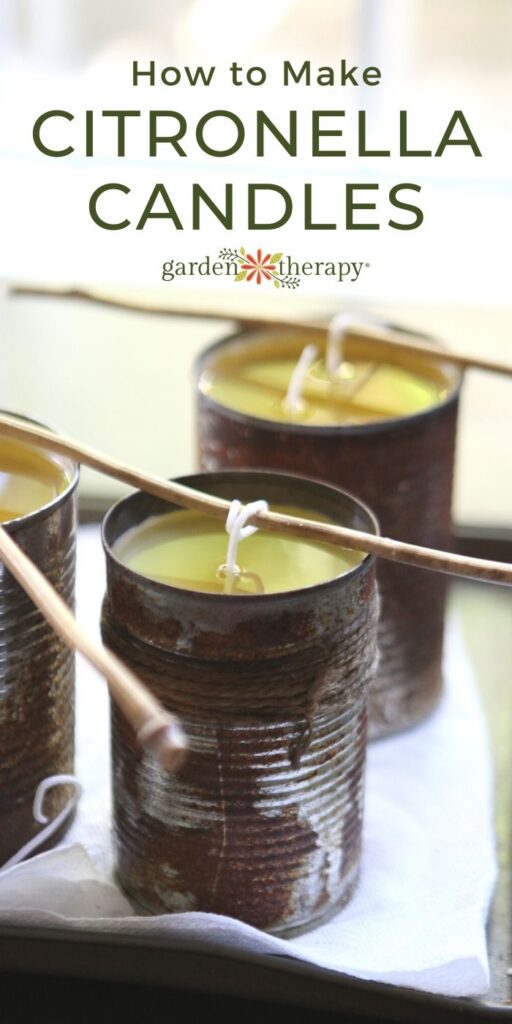
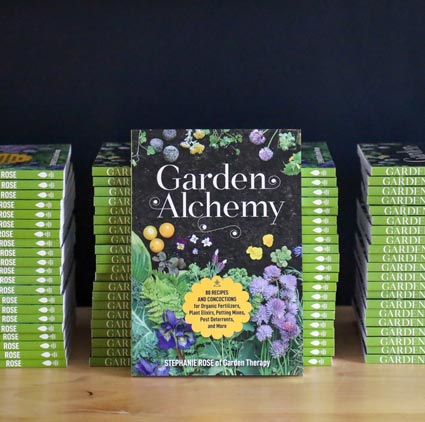


What kind of citronella oil did you use? The only thing I’m finding is essential oil.
Hi Sarah, it’s the same. You can buy large bottles inexpensively at candle shops and online.
Thank You!
You made this so Simple while still an Enjoyable Read… I’m excited to give this a Try!
XOXO